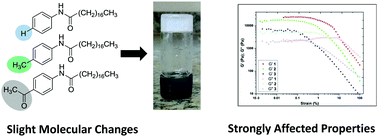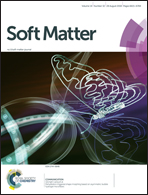Effect of slight structural changes on the gelation properties of N-phenylstearamide supramolecular gels†
Abstract
Supramolecular gels present several applications in which the gelator properties are closely dependent on their structure and solvent. Despite this, there are few studies on the effect of the gelation ability of gelators with slight molecular changes. Therefore, N-arylestearamides (in which aryl = phenyl (1), 4-tolyl (2) and 4-acetylphenyl (3)) were evaluated in different solvents. The critical gelefication concentration (CGC) values indicated that the substituents can significantly affect the concentration at which the supramolecular gels are formed, mainly in non-aromatic solvents (e.g. cyclohexane, acetonitrile and DMSO). From UV-Vis and DSC data, we verified that the gel–sol and sol–gel transitions (Tgel–sol and Tsol–gel) increase in the order of 1 < 2 < 3. Organogel strength was evaluated for 1–3 as a function of concentration and solvent type using rheology data. Gel strength is concentration-dependent and a strength order was found in acetonitrile, cyclohexane and DMSO, in which: 1 ∼ 2 > 3. Dynamic viscoelastic measurements as a function of temperature sweeps indicate a predominantly enthalpic contribution to the elasticity of the organogels formed from 1–3. Temperature-dependent 1H NMR indicates that NH⋯O interactions may be responsible for the molecular association of molecules into 1D fibers, while 3D fibers were formed from van der Waals interactions.



 Please wait while we load your content...
Please wait while we load your content...